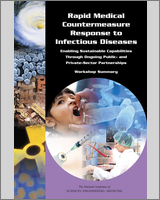From: 6, Developing MCMs for Coronaviruses

Rapid Medical Countermeasure Response to Infectious Diseases: Enabling Sustainable Capabilities Through Ongoing Public- and Private-Sector Partnerships: Workshop Summary.
Forum on Medical and Public Health Preparedness for Catastrophic Events; Forum on Drug Discovery, Development, and Translation; Forum on Microbial Threats; Board on Health Sciences Policy; Board on Global Health; Institute of Medicine; National Academies of Sciences, Engineering, and Medicine.
Washington (DC): National Academies Press (US); 2016 Feb 12.
Copyright 2016 by the National Academy of Sciences. All rights reserved.
NCBI Bookshelf. A service of the National Library of Medicine, National Institutes of Health.